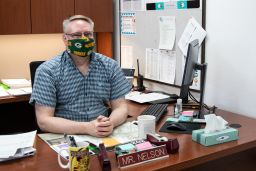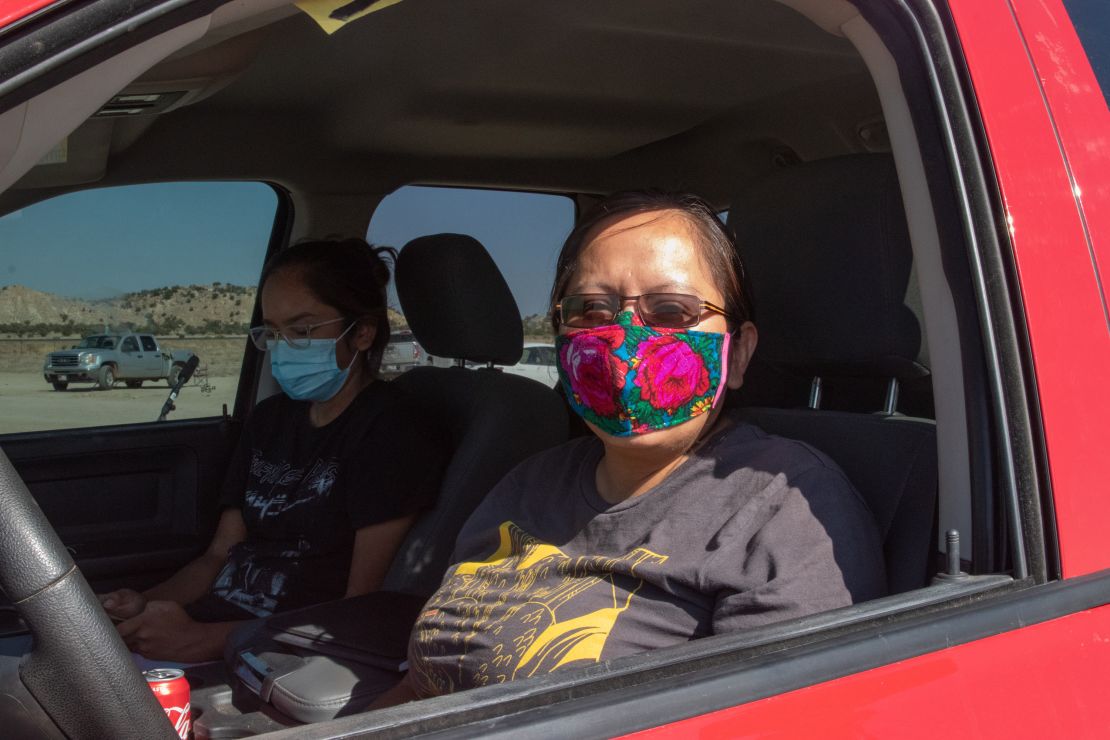A thick cloud of dust kicks up behind cars as they meander down a rugged dirt road into town. The bone-shaking journey to Pinon, Arizona, on the Navajo Nation is a long one filled with sharp bumps and deep potholes.
Much like the drive into Pinon, the Navajo Nation’s struggles with the coronavirus have been far from easy. The community surpassed New York state for the highest Covid-19 infection rate in the United States in May.
The Navajo had 2,304.41 cases of Covid-19 per 100,000 people at its peak in May, compared to the New York state rate of 1,806 cases per 100,000, according to data from Johns Hopkins University.
Since the pandemic began up until November 22, the Navajo Nation has had 15,039 cases out of its population of 173,667 from the 2010 census, which means this hard-hit population has over 8,659 cases per 100,000 people.
A recent surge in positive cases forced the Navajo Nation to go on lockdown until December 6. School is fully online, and most businesses are closed as the Navajo Nation works to reduce the spread of the virus. Essential businesses must close by 3 p.m. each day.
Lack of government support
Piñon High School Principal Timothy Nelson believes there are a number of reasons for the Navajo Nation’s high rate of infection, including a lack of federal and state government support.
“I’ve always said to people, ‘If you want to see a Third World country, look within the United States,’” Nelson said. “Where’s the government funding to help fight this Covid virus here on the Navajo?”

He has not seen any evidence of government aid in Pinon or the towns around it to help fight the pandemic.
“It makes me livid,” Nelson said. “We call ourselves the United States of America, and we’re helping other countries, but we’re not really helping our own.”
In the Navajo Nation, 38% of people live below the poverty line, according to numbers from the 2010 US Census. That’s more than double the US poverty rate of 15.1%, from 2010 census numbers.
At Piñon High School, which is run by the state, over 98% of its students are eligible for the free or reduced lunch program, compared to the state average of 55%.
As the infection rate increased, Nelson said he was afraid to ask people how they were doing because he’d find out that somebody in their family passed away.
A funeral she couldn’t attend
Beverly Mix, a mother of four who lives 15 miles east of Pinon, said her cousin died from the virus and she never got to say goodbye. Only the immediate family could attend the funeral, she said, and they were not allowed to view his body.
“What if they wanted to put things in the casket?” Mix said. “From the hospital, they put him in the casket, and that was it.”
Many other locals share similar stories of heartbreak and loss. Two faculty members at Pinon School District died over the summer from the coronavirus. Robert LaBarge, an English teacher at the high school, has a student in his class who is the grandson of one of the faculty members.
“He’s a kid who’s always pretty upbeat, kind of sarcastic and he’s got an outgoing personality,” LaBarge said. “Immediately you just noticed that it’s kind of gone.”
This nation has scarce resources
The Navajo Nation stretches across much of northeastern Arizona, southeastern parts of Utah and northwestern New Mexico, covering 27,000 square miles. The remote location makes it difficult for people living there to have access to amenities city dwellers take for granted, like Wi-Fi and running water.
Following guidelines from the US Centers for Disease Control and Prevention becomes harder when people don’t have running water to wash their hands or take showers or baths. Staying connected to the latest news and safety information is also a challenge when there is little to no internet access.
Saving the older generation

When people are able to watch the news, Navajo Nation residents like Chenoa Begaye, a senior at Chinle High School and Mix’s daughter, say it’s a challenge convincing their older population to listen.
“Most Natives, we don’t believe what we see on TV,” Begaye said. “We have to have it affect our family and then say, ‘Oh OK, this is serious.’”
Begaye’s grandmother, who is Mix’s mother, is 72 years old and has had a difficult time listening to guidance and adjusting her routine.
“It’s been hard trying to teach her, ‘Put on your mask Mom, put on hand sanitizer,’” Mix said.
Community and spending time with loved ones are highly valued on the Navajo Nation reservation, so it has also been a struggle to help her mother understand that it’s safest to not see others.
“She likes to go visit, and she likes to have visitors, and for us to tell her not to do that, it was life-changing for her,” Mix said.
As the coronavirus swept across the reservation, Mix’s mother has learned to adapt to these guidelines. Nelson also understands that following the rules is crucial because it saves precious lives. However, he admitted the tight regulations have worn him out mentally.
Get CNN Health's weekly newsletter
Sign up here to get The Results Are In with Dr. Sanjay Gupta every Tuesday from the CNN Health team.
“When you are in the thick of it, when you are in a hotspot, it takes a toll,” Nelson said. “I think that’s when reality hits, when you lose someone that you know, somebody who had Covid, and what they went through.”
CNN Features intern Megan Marples visited the Navajo Nation on a reporting trip for Cronkite News at the Walter Cronkite School of Journalism and Mass Communication at Arizona State University in Phoenix.



